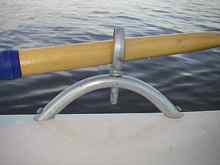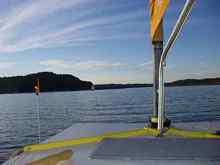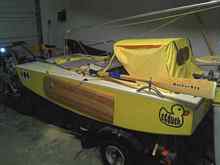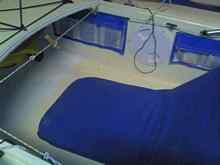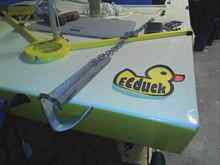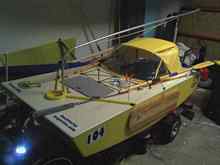
 Custom Search
|
|
| sails |
| plans |
| epoxy |
| rope/line |
| hardware |
| canoe/Kayak |
| sailmaking |
| materials |
| models |
| media |
| tools |
| gear |
 |
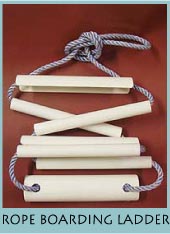 |
| join |
| home |
| indexes |
| classifieds |
| calendar |
| archives |
| about |
| links |
| Join Duckworks Get free newsletter Comment on articles CLICK HERE |
|
|
| A PuddleDuck and the Everglades Challenge - 4b |
by Scott Widmier - Kennesaw, Georgia - USA |
Part One - Part Two - Part Three - Part Four A - Part Four B
Testing and Tweeking - TwoRaising the oarlocks was interesting. I was looking around my workshop trying to think of materials to use to make a nice sturdy lock when I happened to look at a practice dodger frame I had bent out of ¾" galvanized conduit. If I cut off the corners and mounted those on the boat they would make for some nice oarlock risers and a convenient handhold. So, I cut them and through-bolted them onto the boat. Looks good and would give me clearance to row when the mast and sail were on deck. There are some low fixed bridges you have to go under for the Everglades Challenge.
The rest were more minor in nature like switching out the blue seat for a cloth stadium seat that would still fold flat, rounding the tops of the leeboards and attaching the hold-down line through the forward edge so that lowering the leeboards would be easier, and moving the deck hardware around for better geometry. I won't bore you with the details. Next test sail was to be an overnight one so I could test out my preparations for sleeping onboard. I should mention progress on the search for a name. Steadfast or Audacious sounded too Horatio Hornblower and too big a name for such a small boat. The lack of an official name had me calling this the ECduck on the yahoo groups and the more I typed and said it the more that sounded like the right name for this duck. Ironically, John Grey of Polysail.com had recommended this name to me when the topic first came up but I guess it had to grow on me. When someone pointed out that it sounded like "easy duck" I was sold because I want to make the Everglades Challenge easy! Once again, I called my partner in Everglades Challenge craziness, Mistermoon aka John Bell, to go out and overnight on our respective boats. I arrived at the lake early and rowed ECduck out to the main lake. The new oarlocks worked great! Once out on the lake I unrolled the sail and the ECduck began galloping along in a nice wind. After a bit of playing, I tried out the reefing system and rolled in a bit of the sail. I was able to do this without having to stop sailing! Love the new system. I kept the sail reefed for the test-sail with the dodger up. I was able to raise the dodger fairly easily and found I had enough clearance to comfortably sail from inside. Immediately, I was nice and warm though the lack of wind blowing across my skin while sailing took some getting used to. The sunroof that caused a wrinkle in my top was worthless as the angle was wrong for looking at the sail. The performance of the ECduck was once again surprising. I had finally brought along my GPS and was recording speeds of 4.6 knots going to windward with a partially reefed sail! I also had mounted a wind indicator on the deck and I was surprised by how close I could point ECduck while still maintaining good speed. Unless I had the wind coming from the exact wrong direction, or no wind at all, I should be able to make checkpoint 1 before the Sunday deadline. The stadium seat's back was too short meaning it would slip below the aft deck and I would have the wood back there pressing painfully into my back.
Video of the third test sail and first time I had GPS onboard: Soon, I met up with John sailing his Coresound 15 and we turned to head towards our selected cove where we were going to camp for the night. The wind petered out and I found myself ghosting along at speeds too slow for my GPS to register. Time to try out the oars! I found I could row at a steady pace of 2.5 mph with a sprint up to 3 mph. Of course, there were no waves on the lake or headwinds to contend with. Once at the cove, I put the bow of the boat onshore and got off by walking down the reinforced deck. I took my food bag, clothing bag, and hypothermia kit with me so I could prepare dinner and put on some more warmth as the sun set. I gathered some slightly soggy wood and soon had a small fire going using Vaseline soaked cotton balls and some fatwood all from my hypothermia kit. I ate some jerky and protein bars topping off the whole experience with some hot tea made over my esbitt stove. John joined me onshore for a little while to share the fire and I was definitely appreciative of the company. After a while, the cold began seeping in around the fire and we both headed to our respective boats to try out our different sleeping accommodations. John had rigged a sleeping platform on his Coresound 15 and a rather tall boomtent with open ends that I thought wouldn't give much shelter in the rain. All of this took him awhile to set up once he was at anchor. In comparison, I rowed out from shore, threw my baby claw anchor out, and raised my bimini with my stadium seat folded flat. Nice and snug! Immediately, I noticed moisture buildup on the underside of my dodger and I worked hard to avoid brushing against it. A future project would involve better ventilation. I also found it a bit challenging to wriggle my way into my sleeping bag and liner given the small space in the boat. The deck was too low for me to be able to lie on my side which is how I most often sleep. Finally, I hadn't put socks on my feet and they were freezing at the bottom of the bag. Other than these few things, I slept well (kind of). Early in the morning it began to softly rain and I had no problems with water getting in from the outside - just with water dewing up on the inside. John and I awoke early and rowed back to the marina since there was no wind. Back at the boatshed, I reluctantly took off the dodger and went back to the sewing machine. Adding a vent was definitely needed but I was afraid of messing up the whole top. I decided to cut out the worthless sunroof and replace it with some no-seeum mesh killing two birds with one stone. Then, I would add a second layer of dodger material on the top relying on the frames to give some clearance between the two layers. To borrow a phrase from Shorty, I was literally bouncing off the walls when I did a test-fit after these modifications as the second layer sat proud of the first by about an inch. This gives me a nice size vent that should allow are to flow around nicely I did need to add some Velcro to close the vents should wind driven rain try to get in. However, the fact that the vents are on the sides of the dodger means I should be able to use them at anchor even in a solid downpour.
My next tweak worried me almost as much as adding the vent to the dodger. I had decided to cut away my rowing thwart extending the cockpit opening to the curved bolt rope track that defined the front of my dodger. This should give me enough hip room to make sleeping on my side possible and just give me more room overall. I reinforced the deck with a new support beam. I was happy with how it turned out. However, this change would necessitate rowing from a kneeling position or sitting on some cushions. Speaking of cushions, my hunt for the perfect cushion to sit and sleep on continued. I contemplated making something out of wood with some 2 inch closed cell foam on top cut from my wife's favorite pool float. Can you guess why I was a bit hesitant with this approach. The wood would provide the back support and would rest on the lip of the cockpit. Then I thought if I could only disable that racheting mechanism on the blue west marine seat. Then, I remembered one of those seats had a failed mechanism which dumped me on my back at the beach. I found the broken seat and it was perfect! It also would fold in half making a tall enough and cushioned rowing thwart. Now that I had the seat, I decided to add some more comfort to the cockpit in the form of mesh pockets and two cloth shelves (fore and aft of the cockpit) so I could organize small stuff and have it ready to hand.
Now I turned my attention to the anchor. During my test cruise the only place I had to put the anchor was down-below in the cockpit where it would introduce damp and mud. Also, I had to tie off the anchor to the bow handle, an operation that had me perched on the foredeck and not repeatable in any sort of waves. What I really needed was an anchor roller so I scoured the internet only to find ones that were both too big and too expensive. So, I took another stroll through my workshop and my eyes fell on a scrap piece of plastic deck lumber. I cut out a 2" wide by 16" long piece and then used the table saw to cut a V shaped channel down the middle. I then bolted this through deck beams on the port bow. On the outboard end I attached a bail to capture the anchor when retrieving and to channel the chain and rode. I ran the chain through a bronze open anchor fairlead over the forward water deflector and then back to a cleat on the port side just forward of the cockpit. Testing in the garage proved only a small shove was needed on the anchor to get it to deploy and it easily pulled up to rest on the anchor sprit. Now, what to do about the rode storage? I remember seeing the mesh area forward of the cockpit on kayaks and thinking how nice of an area it was for wet storage. I happened to have some nice shock cord and eyelets so decided to do the same thing in front of the cockpit on ECduck. I then stole a mesh bag from an old snorkel set the kids had outgrown, put the anchor rode in there with the bitter end out through a hole in the bottom and tied off to the cleat, and tucked it under the shock cord. The whole setup is nice and secure and I couldn't wait to try it out. An easy to deploy anchor is an important piece of safety equipment on a boat in the shallow Florida waters.
The new oarlocks were a success on my last trip and I was even able to do some sculling with one oar even though I didn't have full motion. I needed to devise a way to store the oars and come up with a propulsion system where I could sit facing forward. First, I drilled holes in the bottom of the oarlocks so that I could run through some pins below the sockets. I was using rings so the oars wouldn't be able to fall overboard. Next, I added another bit of shockcord port and starboard that I could slide the oars forward and tuck the handles under. With the handle tape in contact with the deck, the oars do not show the slightest tendency to slide around when tucked away yet are easily and quickly deployed. I then added an oarlock on the transom and made yet another version of the fishtail drive out of flexible PVC pipe and Lexan. I filled all the holes my moving around of hardware created and put a fresh coat of paint on the deck and hull. I bought some "waterproof" inkjet stickers from https://www.onlinelabels.com. I got the matte finish though in hindsight I wish I had gotten the glossy. The stickers came and I printed out the name of the boat along with the websites for my sponsors and the class. I tested one of them out by soaking it in the sink and it actually did seem to be waterproof. These went on the boat and it started to look like a little expedition craft!
Another good Saturday came up for testing the boat. I briefly contemplated sleeping on it Friday night but temperatures near freezing, lower than I should face on the EC, caused me to chicken out. Out to the marina I headed with my duck in tow. When I got there, I found ECduck had almost fallen off the side of the trailer. I had forgotten to reattach the rear ropes and I couldn't see what was happening to the duck behind my van. I have to get a hitch on my Mazda 3! I waived at a few of my sailing club members who had been lured out by the same great sailing forecast and were busy doing some winter delayed projects before heading out. One great thing about ECduck is she is very quick to rig. I trailer her with everything but the mast in place and, since it is carbon fiber and lightweight, the mast only takes a few seconds to stick in the mast step with sail already attached. Hardest part of launching is, once again, backing a boat and trailer you can't see down the ramp. I got the EC duck launched, van parked, and I headed out. First thing I wanted to try was the new fishtail sculling oar. Let's just say it was less than successful and leave it at that. It was very good at turning the boat but much less successful in getting it to travel in a straight line. I dropped the fishtail oar off in the cockpit of my bigger boat and headed out on the main lake. When I first got out the wind was fairly nonexistent which was bit of a surprise given the forecast. So, I unrolled the sail and did some fiddling with the new storage pockets. After a little while the wind filled in and I started sailing east towards Victoria Landing, site of the 2009 PD Racer World Championship. I wanted to sail beyond into the S-bends because I hadn't been back there in a while and I knew the swirling winds back there would really get me acquainted with the sailing characteristics of my boat. On that stretch of lake I can experience the same variety of wind conditions in an hour that I would experience during a week of sailing in Florida. Think of it as coastal sailing on fast forward. First, though, I had a fairly open part of the lake to sail down and the wind was building nicely. Part of the way down I noticed the big boats, a Hunter 21 and a Catalina 22, had come out to play and were sailing to catch up with me. Their skippers, Steve and Andy, are good friends and both have built Puddle Duck Racers so they were very curious to see how mine did on the water. The thing that surprised us all was how long it took them to catch up with the ECduck. In the steady winds I was easily maintaining a speed over 5mph and they didn't catch up until I got to the swirling winds of the first S-bend. The other pleasant surprise was the confirmation of how close winded the ECduck is being able to point at least as well as a Catalina 22 sloop. The wind continued to build and the S-bends provided me plenty of opportunity to learn the boat going from a dead calm to a howling wind in moments. After a bit of sailing in these conditions I called a break and we headed over to a protected cove to anchor for lunch. The anchor sprit worked extremely well. I was so tickled with it that I anchored three times under the guise of getting into a better location to talk with Steve and Andy in their boats. I ate two energy bars and some Craisins all of which I plan on using during the Everglades Challenge. They did potluck with whatever they found in the forgotten niches on their boats. Via phone we learned a couple more sailing club members were coming out and John Bell was launching his Core Sound 15 and sailing down to meet us. We leisurely packed up lunch and headed back to the more open part of the lake meeting John part of the way there. When I first started sailing I put the dodger up so Steve and Andy could see me sailing with it. When I had it up, I noticed a nice draw of air out of the new vent in the top and no build-up of moisture. I ended up putting it back down as the wind had built even more and the S-bends were being especially cruel throwing wind gusts from unpredictable directions requiring a more direct feel of the conditions. I reefed the sail a little then a little more enjoying how well the new reefing lines were working. ECduck was proving a very stable boat though her tendency to dive down when over canvassed was problematic in those erratic winds. Still, I was as comfortable, if not a little more, than some of the folks in the larger boats. John Bell's Coresound 15 really flew with the winds primarily behind us leaving all of us in his wake. Back in the wider part of the lake we reveled in the sight of nine sailboats and zero powerboats on the lake as we romped back towards the marina. The winds continued to build past 20mph and some darker clouds rolled in encouraging boats to head back to the dock. I sailed past the marina into an area where the wind was really getting funneled to test out the stability of the boat. I rolled all but a small bit of the sail up and was still hitting speeds over 4mph to windward. I did notice my pointing ability declining as the wind increased. This whole sail I had been watching my thin boom take on more of a permanent bend which proved what my gut was telling me all along, it was too thin. After briefly playing in the strong winds, I turned the boat towards to join all of the larger boats at the marina. I recovered the boat, easy but for the backing of the trailer into the water, and went to visit with folks and give them a close up look at the ECduck. My "tweaks" will continue with the boom and reinforcing of the oarlocks being next on my list. I don't think I will be fully done with the boat even when it is sitting on the beach at Fort Desoto. For the boom, I found a metal supplier 5 miles from my house called Metal Supermarket that has 1.5" aluminum pipe and can bend it into the shape I want for the boom. It will be both lighter and stronger than the galvanized conduit I have been trying on the boat. I also plan on getting some angled aluminum to use for strengthening the boat where the oarlocks attach. |
 |
